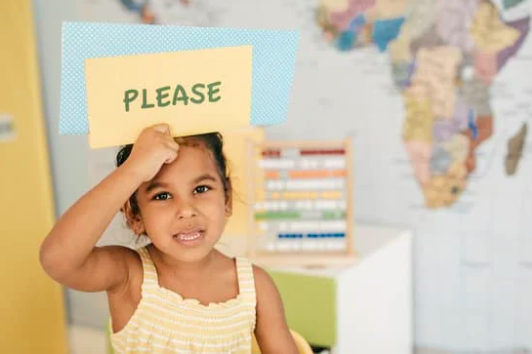 Patricia P. Gage, Ph.D
Patricia P. Gage, Ph.D
School & Consulting Psychologist
Facebook
 Living in a household with a strong-minded grandma, lovingly called “Yiayia”, for the last 30 years has served as a reminder of the importance of good manners and etiquette. There was no free pass for bad manners in our house. We didn’t realize the impact of her presence on our behavior and probably did not appreciate it as much as we should have until she was no longer with us.
Living in a household with a strong-minded grandma, lovingly called “Yiayia”, for the last 30 years has served as a reminder of the importance of good manners and etiquette. There was no free pass for bad manners in our house. We didn’t realize the impact of her presence on our behavior and probably did not appreciate it as much as we should have until she was no longer with us.
Three-fourths of Americans think manners and behavior have deteriorated in the United States over the last two decades due to a serious generation gap when it comes to etiquette rules. Good manners are often defined as the acceptable conduct that parents and teachers often ask from students. Instilling good manners in your children makes them more courteous, thoughtful, empathetic, and easier to relate to and teach. This makes them more likely to succeed in all aspects of life. Clarence Thomas’ wise words can also serve as a reminder that “good manners will open doors that the best education cannot”.
Why Do Good Manners Matter?
Good manners and etiquette are looked upon in our society as an indicator that a child was brought up well. As always, you can serve as the best role model by exhibiting the best manners in front of your children so they can learn by watching you. This is no easy task, but it does help if you as parents understand and value the importance of good manners in children and make sure your children exhibit them. You want to be modeling and emphasizing the behavior that you want them to demonstrate and not the behavior you want them to stop. As their main role model, you must remain calm no matter how frustrated you may be and refrain from using punishments.
There is more to manners than just saying “please”, “thank you” and writing thank you notes for gifts you receive. Manners are often indicative of your character, who you are, and what you value. Johann Wolfgang Von Goethe once said: “A man’s manners are a mirror in which he shows his portrait”. It’s important to reflect on what good manners mean to you and what are some of the ways that you can practice good manners for your children, daily.
For most people practicing good manners is a way of demonstrating self-respect and a way of respecting others. If someone opens the door for you and you look them in the eye and say thank you, it shows that you appreciate their gesture and that you are a thoughtful person. If a waiter asks if you like more coffee and you say “please”, you are letting him know that you are asking not demanding it of him. Manners are simply an awareness of other people’s feelings and a way of showing respect for them. It will certainly add to your child’s confidence in dealing with others and being viewed as a polite person.
How to Teach Children Manners
Like any other skill practicing it frequently will make it a habit. As we often say, if you do something consistently for 30 days it becomes a habit. Most importantly, as you start to receive more positive reactions from others on your good manners, it makes you feel good and it starts to come more naturally to you. In teaching manners, you want to be patient, and look for opportunities to teach them using specific situations that occur naturally, but not embarrass your children in front of others. Do your best to refrain from yelling, nagging, or punishing while you’re teaching and modeling politeness. You want to reinforce manners around fun activities and family times as much as possible. If you’re not sure how or what to teach young children look up some videos or get a children’s book about manners from your local library, appropriate to your child’s age. A Smart Girl’s Guide to Manners by Nancy Holyoke, and Good Manners Guide by Stacy Farrell is a good start to begin this conversation or play fun games such as Blunders, Yes Please, No Thank You Holiday Meal Manners Game, Good manners Game for Pre-K-3rd grade. Free manners worksheets and art activities for different ages are available such as Cover Your Sneeze. Investigate appropriate game apps on manners that children can play on their own. The best approach is when you can discuss why it is important to have good manners and how it will benefit them in life. Take the time to demonstrate a particular manner. For example, role-play the following steps for an introduction to a guest: make sure you actively listen by making eye contact with the person you’re speaking with, extend your hand for a handshake, and remember to smile.
Look for classes that may be offered in your area. When my boys were in middle school a speaker was brought in to teach a class on manners by their school. My boys thought they didn’t need the classes until I suggested that they should attend to be ready in case they wanted to take a girl out on a date. That seemed to motivate them, and it turned out that the instructor used the dating scenario to discuss how to: use table manners, pick up the girl for the date, meet the parents, open the door, and pull out the chair for her to sit, make eye contact, remember her name, etc. When they did start to date, I always reminded them that they should learn something new about that person each time they go out. This kept them from talking only about themselves and showing personal interest in their date.
When your child acts appropriately and demonstrates etiquette make sure that you notice and use words that will give him positive reinforcement and encouragement. Make your praise specific and focus on the effort not necessarily the result. You can also gently correct your child on the spot when he engages inappropriately without embarrassing him or if need be wait until you can do it privately. If you ignore your child’s manners, he may resort to negative behavior to get your attention. After a display of inappropriate behavior, you always ask what could have been done or said in its place in that particular situation and encourage him to keep trying.
If your child is at an appropriate age to understand your instructions and has been given ample opportunities to practice a specific manner, but he/she continues to engage in inappropriate manners, then you can begin to impose reasonable consequences related to the behavior. For example, if he/she refuses to write a note for the gift grandma sent him then tell grandma to stop the gifts until he or takes the time to properly thank her. Threats rarely work so try to use them only when absolutely necessary and use positive reinforcement as often as you can. Always remind them that you are there for them and that they can come to you with any questions that they may have.
Important Manners to Teach Your Children
- The first and most basic manners to teach kids from a very young age is to say “please”, “thank you” “you’re welcome” “may I” “excuse me” and “sorry”. It can be as simple as saying thank you when someone passes the food to you at the table to writing a note when you receive a gift. Be specific about why you’re thanking the person and take the time to write a personal note. Remember to teach them to sign the note with their first name, not with their formal, “business-like” signature. Learning to show gratitude is teaching kids the difference between entitlement and being gifted something out of kindness. These small gestures can make a big difference in raising children to be more mindful of others, learning to put other people’s needs first, and cultivating a thankful heart.
- Asking for permission politely to use or borrow something even if it is a family member and saying thank you when they return it.
- Do not interrupt when someone is speaking. Children need to practice saying excuse me and asking for permission to speak. They need to know that it’s ok to interrupt an adult in an emergency or if someone is getting hurt.
- Practice phone etiquette and how they can take a message for another member of the family. They should know when to stay quiet and listen when the person is talking and wait until they finish before beginning to talk.
- Children need to learn to be respectful to people of other races, religions, gender, or someone with a disability They need to know that making fun of or bullying people is extremely hurtful and this type of behavior is unacceptable in public or privately.
- Kids need to be reminded to show respect toward their parents, grandparents, teachers, and the elderly that they come in contact with. You can demonstrate for them by offering your seat to an elderly person on public transportation or in a waiting room, volunteering and serving together at a soup kitchen, calling and checking on grandparents and elderly neighbors, and offering to do small tasks that will make their life easier. Remember to shake their hand when meeting them and making a point to learn and remember the person’s name and title before you address them as, Mr., Mrs., Ms., or Dr.
- Respect people’s privacy. Teach kids to knock on the door and wait for permission before entering a room.
- Cover their mouth when they have to sneeze or cough. In a one-on-one conversation avoid being too close to the person’s face. Maintaining about an arms-length distance when speaking to others works well.
- How to be a good guest when visiting someone’s home. They should expect to go along with the family’s schedule, do their best to eat what they are served, help with the clean-up and express their gratitude for the hospitality. If they are on a play date, they are to allow the host to be first at selecting the activity. They are to speak softly and communicate their needs no matter how upset or irritated they feel during the play date/visit.
- Learn to be helpful and show compassion toward others. Small gestures like holding the door open for someone who has his hands full of packages, helping an elderly neighbor or a busy mom with babies to unload their groceries, offering to do chores in the house, such as taking out the garbage, feeding a pet, clearing their plates and placing it in the sink after meals, helping to set the table.
- Learn to share toys and supplies in school when playing with others or eating their lunch and snacks at a table with other kids.
- A core value that you want to demand is for kids to learn to be honest. From a young age, they need to learn to do what they said they would do, keep their promises, and not lie.
- Children are often very loud without even noticing. Teach them how toadjust their speaking volume depending on where they are. For a young child, you can use a scale from 1 to 10 and remind him that he is more like a 9 or 10 if he’s too loud and should be more like a 5 in the restaurant, during dinners at home, and other public gatherings.
- Reinforce the importance of never using foul language, no matter where they are or who they are speaking to.
- Learn when toturn off the phone, or silence it for example: in movie theaters, at parties, houses of worship, in school, at family dinners, or in restaurants.
- Whether your child receives an evite or a paper invitation make it a point to instill in your child the importance to promptly RSVP so that the host can prepare and not have to get on the phone to call people. Children often don’t like to make the call and may be too embarrassed or simply forget. It’s an important manner as a way of showing gratitude and respect. In addition, talking to them about being on time for the event and dressing appropriately can go a long way in getting more invitations in the future and getting positive feedback from others. Regardless of their age kids need help to learn how to get organized and how to estimate how much time it will take for them to get to their next activity or destination, to avoid being late.
- Table manners are essential skills for children of all ages. Waiting until everyone is seated and served before starting to eat their meal is important. Regardless of age, it won’t hurt them to learn to wait whether they are in a restaurant or at home. Reinforce table manners at all times and all settings until they become automatic and a consistent habit. Here are some essentials for dining etiquette:
-
- Wash your hands before you sit at the table to eat
- Place the napkin in your lap when you sit to eat, folded in half. Throughout the meal, the napkin stays placed on the lap folded, if you have to leave the table place it in your chair, not on the table while you’re gone. Never use your napkin to wipe or blow your nose
- Use utensils starting from the outside
- The fork and spoon above the place setting are to be used for dessert
- Your side /roll plate is on your left
- Your water glass is on your right
- Cut your food with a fork in the left hand and a knife in the right hand. Use your index finger to point your fork with prongs on the fork face down to pierce your food. You then place the knife down and change the position of your fork to the right hand with the prongs facing up to eat. This goes for left-handed kids as well.
- Hold utensils correctly, don’t stab your food using your whole fist. Hold the fork the way you hold a pencil, the shank extended between your thumb and index and middle fingers. Your fourth and fifth fingers should rest in your hand.
- Ask for food to be passed to you instead of reaching across the table
- Engage in conversation. For young children ask them what was the best part of their day or encourage them to share a joke as a way of getting them involved. Kids can look up jokes ahead of time at jokesforkids.lol, funkidsjokes.com, https://www.rd.com
- Wait to check phone calls or texts until you are finished with your meal and away from the table
- Keep your mouth closed when you eat
- Cut one piece of food at a time
- Don’t place your elbows on the table while eating
- Remember to thank the hostess/parent for preparing the meal
- Discuss what your children can and cannot do when they are involved in social media. Discuss the dangers of posting inappropriate pictures, tagging other people without their consent, giving out personal information or information on others without their consent, and never saying things about others that they would not say in person. Kids should know you will be checking their computers periodically if needed.
It’s easy to get frustrated when you have to repeat yourself constantly when teaching specific skills to children. Consider their short attention span and incredibly busy minds. Staying calm, being persistent, and noticing the positives even if they are only close approximations of what you would like them to do, will eventually lead to ultimate success. A simple ritual such as having a treasure box somewhere in the house with stickies that kids can pull and write something they did that day such as, “I held the door open for my teacher when we went to lunch” and place it in the box. When the box fills up it’s a family celebration, such as pizza night!
In starting the conversation with your children, particularly with middle schoolers, you can look for specific situations when you observed your child using good manners and take advantage of the moment to acknowledge it and have a discussion. If that doesn’t happen, be more specific and begin with some questions like, can you think of a time during your day-to-day that you demonstrated good manners? When have you demonstrated your best manners? What happened? How did the people around you react? Are there some good manners that you think you need to practice? Why? Do you think good manners matter? Do you have a friend that you admire for his/her good manners? Were you ever told to be more respectful? How did that make you feel at the time? Have you remembered to say “please” and “thank you” at any time today?
Someone once said, “to be courteous is to be humble”. You can make a difference in someone’s day with a simple thank you and an acknowledgment of a service provided to you. Good manners will only make your child a more likable person, more successful, and easier to get along with others. Getting positive responses gives kids a sense of happiness, and they are more likely to repeat the behavior. A polite and considerate child will make the best impression and leave a valuable imprint on the world and in the hearts of everyone they come in contact with. What a legacy for a parent to leave behind.

About Dr. Gage
Dr. Gage has been a practicing school psychologist for over 30 years. She holds a Bachelor of Arts degree in Elementary Education and Psychology from Hunter College, a master’s degree in School Psychological Services and a Ph.D., in Child/School Psychology from New York University. She has been an active member of her community as a compassionate advocate for children’s social and emotional wellness and the rights of students with learning differences. She has been instrumental in implementing several successful programs in Martin County, Florida, such as the Mainstream Instructional and Behavioral Consultation Program for the Martin County Schools, “Weebiscus”, a preschool program for Hibiscus Children Center and the Academic Center at The Pine School.
Dr. Gage has served on the Board of the Rotary Club of Stuart, The Pine School, Hibiscus Children Center, and Sandy Pines Residential Treatment Center. She was a tireless member of The Rotary Foundation/ Matching Grants, the Rotary Youth Leadership Assembly, and served as the mental health counselor for the Rotary Student Exchange Program. Dr. Gage is the proud co-founder of a second company, Hang In There, LLC, which writes and produces a series of guides for new parents. The company has already donated over 15,000 guides to organizations serving new parents. She was the 2003 recipient of the Soroptomist International Women of Distinction award and was selected Rotarian of the Year 2002-2003 and 2009-2010.
Pat is married to Dr. Joseph Gage, a local Cardiologist, and is the proud mother of two wonderful sons. She loves photography, gardening, and traveling with her family.
Find her at brainsmartacademics.com.
View all posts by Dr. Gage here.







3 Comments on “Parents Still Need to Teach Children Good Manners”
I have read your article; it is very instructive and valuable to me. I admire the valuable information you offer in your articles. Thanks for posting it.
Kids today seem like they don’t have any manners. When I was young I always said thank you. There are alot of very young parents today, basically babies having babies. Sad
great article